Effect of Shellac Waterborne Coating Microcapsules on the Optical, Mechanical and Self-Healing Properties of Waterborne Primer on Tilia europaea L. Wood
Abstract
:1. Introduction
2. Materials and Methods
2.1. Experimental Materials
2.2. Preparation of Microcapsules
2.3. Preparation of Waterborne Coatings
2.4. Testing and Characterization
3. Results and Discussion
3.1. Morphology and Composition Analysis of Microcapsules
3.2. Effect of Microcapsule on the Optical Properties of Surface Coating on Tilia europaea L. Wood
3.3. Effect of Microcapsules on the Mechanical Properties of Surface Coating on Tilia europaea L. Wood
3.4. Effect of Microcapsule on liquid Resistance of Surface Coating on Tilia europaea L. Wood
3.5. Effect of Microcapsules on the Microstructure and Composition of Surface Coating on Tilia europaea L. Wood
3.6. Effect of Microcapsules on Aging Resistance of Surface Coating on Tilia europaea L. Wood
3.7. Effect of Microcapsules on the Self-Healing Properties of Surface Coating on Tilia europaea L. Wood
4. Conclusions
Author Contributions
Funding
Institutional Review Board Statement
Informed Consent Statement
Data Availability Statement
Conflicts of Interest
References
- Ullah, H.; Azizli, K.A.M.; Man, Z.B.; Ismail, M.B.C.; Khan, M.I. The potential of microencapsulated self-healing materials for microcracks recovery in self-healing composite systems: A review. Polym. Rev. 2016, 56, 429–485. [Google Scholar] [CrossRef]
- Chen, M.F.; Fan, D.C.; Liu, S.M.; Rao, Z.L.; Dong, Y.L.; Wang, W.X.; Chen, H.; Bai, L.J.; Cheng, Z.P. Fabrication of self-healing hydrogels with surface functionalized microcapsules from stellate mesoporous silica. Polym. Chem. 2019, 10, 503–511. [Google Scholar] [CrossRef]
- Zhang, C.B.; Gao, W.; Zhao, Y.J.; Chen, Y.P. Microfluidic generation of self-contained multicomponent microcapsules for self-healing materials. Appl. Phys. Lett. 2018, 113, 203702. [Google Scholar] [CrossRef]
- Niu, R.W.; Jin, M.L.; Cao, J.P.; Yan, Z.B.; Gao, J.W.; Wu, H.; Zhou, G.F.; Shui, L.L. Self-healing flexible conductive film by repairing defects via flowable liquid metal droplets. Miromachines 2019, 10, 113. [Google Scholar] [CrossRef] [Green Version]
- Feng, H.Y.; Yu, F.; Zhou, Y.; Li, M.; Xiao, L.H.; Ao, Y.H. Fabrication of microcapsule-type composites with the capability of underwater self-healing and damage visualization. RSC Adv. 2020, 10, 33675–33682. [Google Scholar] [CrossRef]
- Song, Y.K.; Kim, B.; Lee, T.H.; Kim, J.C.; Nam, J.H.; Noh, S.M.; Park, Y.I. Fluorescence detection of microcapsule-type self-healing, based on aggregation-induced emission. Macromol. Rapid Comm. 2017, 38, 1600657. [Google Scholar] [CrossRef]
- Yan, X.; Qian, X.; Chang, Y. Preparation and characterization of urea formaldehyde @ epoxy resin microcapsule on waterborne wood coatings. Coatings 2019, 9, 475. [Google Scholar] [CrossRef] [Green Version]
- Tan, X.Y.; Zhang, J.P.; Guo, D.; Sun, G.Q.; Zhou, Y.Y.; Zhang, W.W.; Guan, Y.S. Preparation, characterization and repeated repair ability evaluation of asphalt-based crack sealant containing microencapsulated epoxy resin and curing agent. Constr. Build. Mater. 2020, 256, 119433. [Google Scholar] [CrossRef]
- Ma, L.L.; Shang, Y.N.; Zhu, Y.D.; Zhang, X.N.; Jingjing, E.; Zhao, L.H.; Wang, J.G. Study on microencapsulation of lactobacillus plantarum LIP-1 by emulsification method. J. Food Process. Eng. 2020, 43, e13437. [Google Scholar] [CrossRef]
- Khodabakhshaghdam, S.; Khoshfetrat, A.B.; Rahbarghazi, R. Alginate-chitosan core-shell microcapsule cultures of hepatic cells in a small scale stirred bioreactor: Impact of shear forces and microcapsule core composition. J. Biol. Eng. 2021, 15, 14. [Google Scholar] [CrossRef]
- Fan, C.J.; Zhou, X.D. Influence of operating conditions on the surface morphology of microcapsules prepared by in situ polymerization. Colloid. Surface. A 2010, 363, 49–55. [Google Scholar] [CrossRef]
- Schultz, S.; Wagner, G.; Urban, K.; Ulrich, J. High-pressure homogenization as a process for emulsion formation. Chem. Eng. Technol. 2004, 27, 361–368. [Google Scholar] [CrossRef]
- Knupfer, P.; Ditscherlein, L.; Peuker, U.A. Nanobubble enhanced agglomeration of hydrophobic powders. Colloid. Surface. A 2017, 530, 117–123. [Google Scholar] [CrossRef]
- Mozaffari, S.M.; Beheshty, M.H.; Mirabedini, S.M. Effect of processing conditions on the microencapsulation of 1-methylimidazole curing agent using solid epoxy resins. Iran. Pol. J. 2017, 26, 629–637. [Google Scholar] [CrossRef]
- Zhang, C.; Wang, H.R.; Zhou, Q.X. Preparation and characterization of microcapsules based self-healing coatings containing epoxy ester as healing agent. Prog. Org. Coat. 2018, 125, 403–410. [Google Scholar] [CrossRef]
- Wang, Q.P.; Cao, J.Z.; Liu, X.E.; Yang, S.M.; Jiang, M.L. Self-healing coatings for inhibiting corrosion of ferrous metals exposed to preservative-treated bamboo. J. Wood Sci. 2020, 66, 18. [Google Scholar] [CrossRef] [Green Version]
- Wang, H.R.; Zhou, Q.X. Evaluation and failure analysis of linseed oil encapsulated self-healing anticorrosive coating. Prog. Org. Coat. 2018, 118, 108–115. [Google Scholar] [CrossRef]
- Pedaballi, S.; Li, C.C.; Song, Y.J. Dispersion of microcapsules for the improved thermochromic performance of smart coatings. RSC Adv. 2019, 9, 24175–24183. [Google Scholar] [CrossRef] [Green Version]
- Zandi, M.S.; Hasanzadeh, M. The self-healing evaluation of microcapsule-based epoxy coatings applied on AA6061 Al alloy in 3.5% NaCl solution. Anti-Corros. Method. Mater. 2017, 64, 225–232. [Google Scholar] [CrossRef]
- Durmaz, S.; Ozgenc, O.; Avci, E.; Boyaci, I.H. Weathering performance of waterborne acrylic coating systems on flat-pressed wood-plastic composites. J. Appl. Polym. Sci. 2020, 137, 48518. [Google Scholar] [CrossRef]
- Wu, Y.; Wu, J.M.; Wang, S.Q.; Feng, X.H.; Chen, H.; Tang, Q.W.; Zhang, H.Q. Measurement of mechanical properties of multilayer waterborne coatings on wood by nanoindentation. Holzforschung 2019, 73, 871–877. [Google Scholar] [CrossRef]
- Li, J.; Shan, W.W.; Cui, J.C.; Qiu, H.X.; Yang, G.Z.; Zheng, S.Y.; Yang, J.H. Enhanced corrosion resistance and weathering resistance of waterborne epoxy coatings with polyetheramine-functionalized graphene oxide. J. Coat. Technol. Res. 2020, 17, 171–180. [Google Scholar] [CrossRef]
- Yu, J.F.; Pan, H.X.; Zhou, X.D. Preparation of waterborne phosphated acrylate-epoxy hybrid dispersions and their application as coil coating primer. J. Coat. Technol. Res. 2014, 11, 361–369. [Google Scholar] [CrossRef]
- Liu, Q.Q.; Gao, D.; Xu, W. Effect of sanding processes on the surface properties of modified Poplar coated by primer compared with Mahogany. Coatings 2020, 10, 856. [Google Scholar] [CrossRef]
- Liu, Q.Q.; Gao, D.; Xu, W. Influence of the bottom color modification and material color modification process on the performance of modified Poplar. Coatings 2021, 11, 660. [Google Scholar] [CrossRef]
- Hu, J.H.; Li, Y.; Yi, L.; Guo, H.W.; Li, L. Evaluation of the dyeing properties of basswood veneer treated by dichlorotriazine reactive dye based on gray correlation analysis. BioResources 2016, 11, 466–481. [Google Scholar] [CrossRef] [Green Version]
- Yang, H.M.; Yu, L.; Wang, L.H. Effect of moisture content on the ultrasonic acoustic properties of wood. J. Forestry Res. 2015, 26, 753–757. [Google Scholar] [CrossRef]
- Bousack, H.; Kahl, T.; Schmitz, A.; Schmitz, H. Towards improved airborne fire detection systems using beetle inspired infrared detection and fire searching strategies. Micromachines 2015, 6, 718. [Google Scholar] [CrossRef] [Green Version]
- Wu, S.S.; Tao, X.; Xu, W. Thermal conductivity of Poplar wood veneer impregnated with graphene/polyvinyl alcohol. Forests 2021, 12, 777. [Google Scholar] [CrossRef]
- Mei, S.; Han, P.P.; Wu, H.; Shi, J.F.; Tang, L.; Jiang, Z.G. One-pot fabrication of chitin-shellac composite microspheres for efficient enzyme immobilization. J. Biotechnol. 2018, 266, 1–8. [Google Scholar] [CrossRef]
- Zhou, J.; Yang, L.; Wang, X.L.; Fu, Q.J.; Sun, Q.L.; Zhang, Z.Y. Microencapsulation of APP-I and influence of microencapsulated APP-I on microstructure and flame retardancy of PP/APP-I/PER composites. J. Appl. Polym. Sci. 2013, 129, 36–46. [Google Scholar] [CrossRef]
- Yan, X.; Zhao, W.; Qian, X. Effect of water-based emulsion core microcapsules on aging resistance and self-repairing properties of water-based coatings on Linden. Appl. Sci. 2021, 11, 4662. [Google Scholar] [CrossRef]


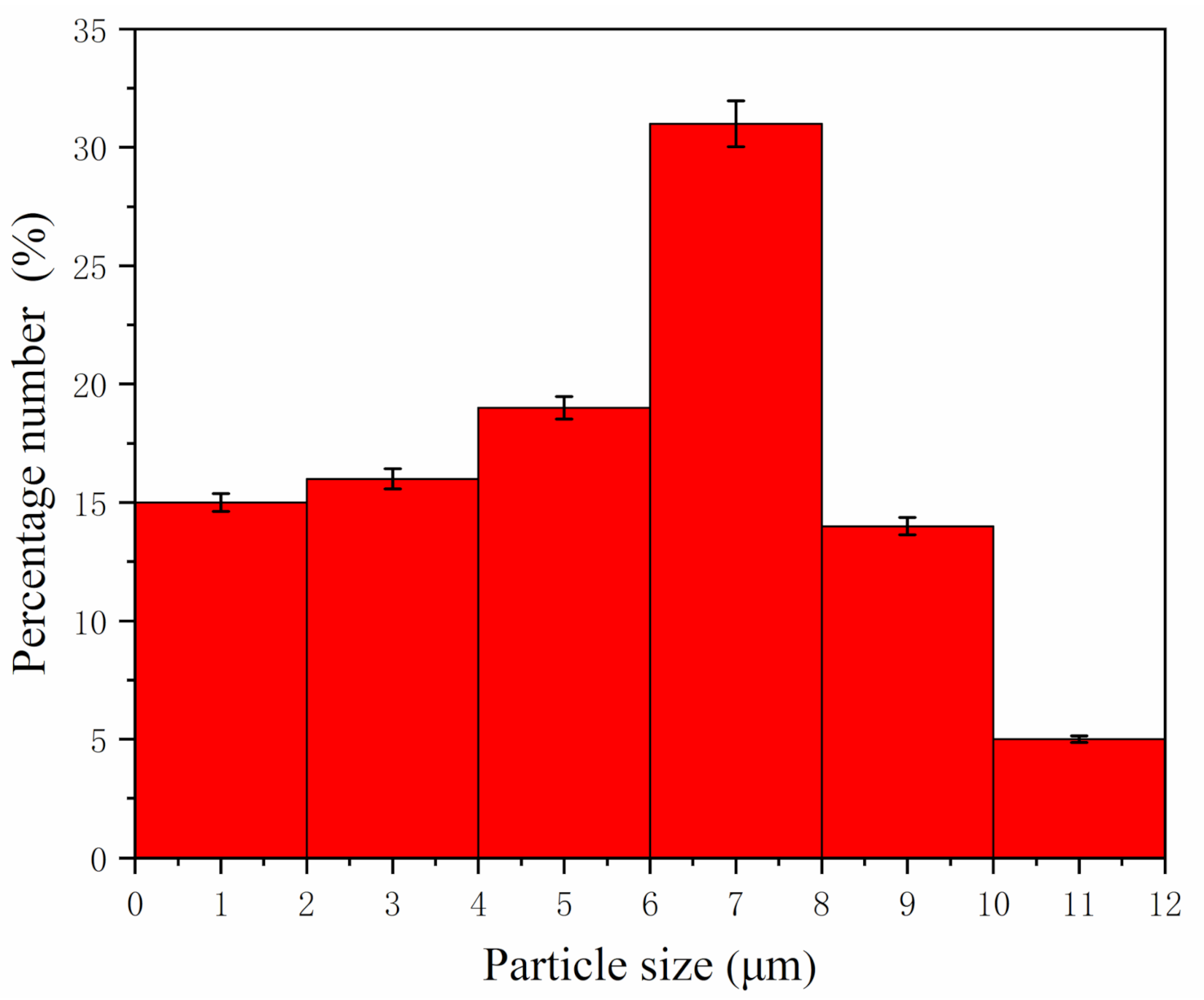


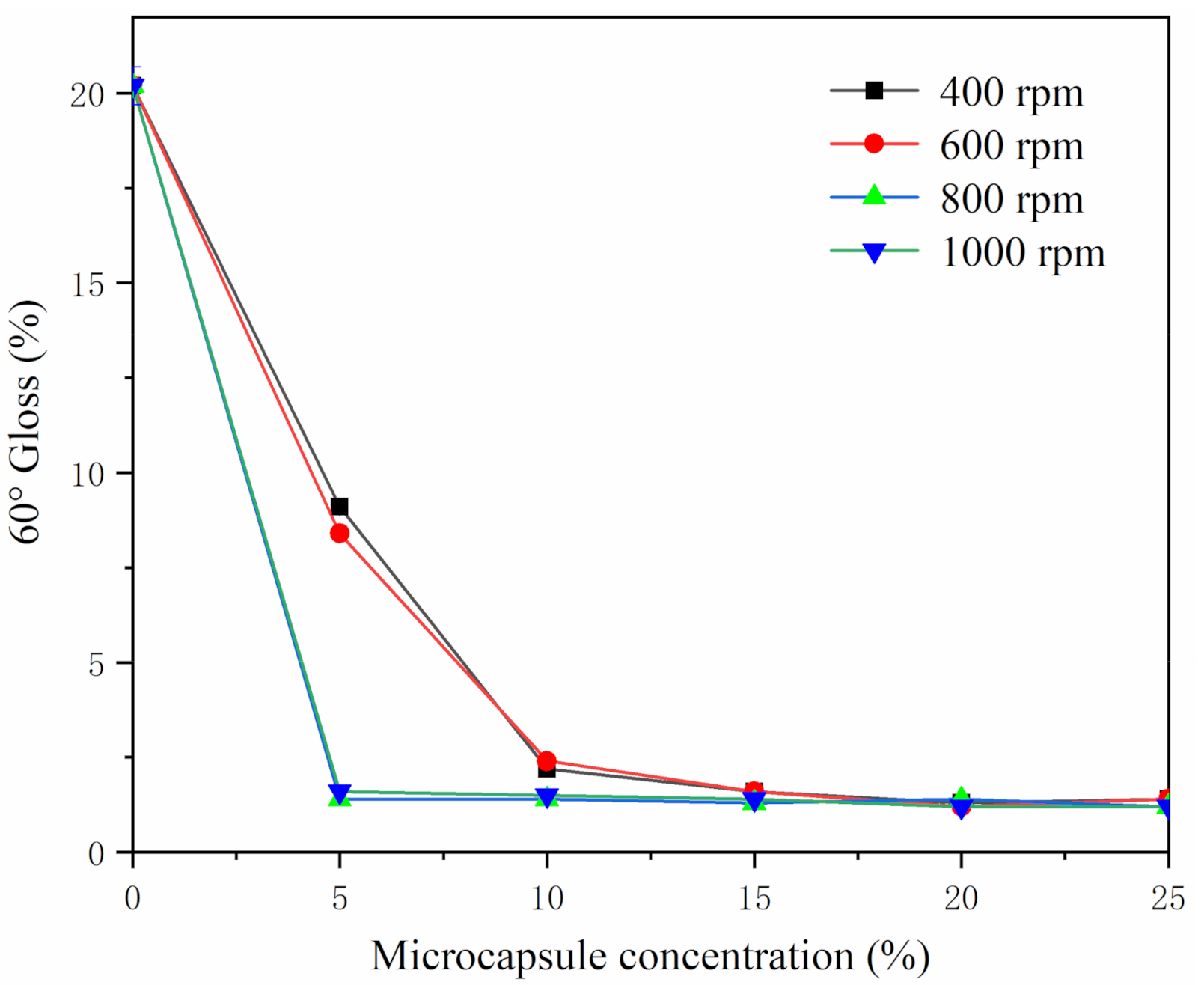
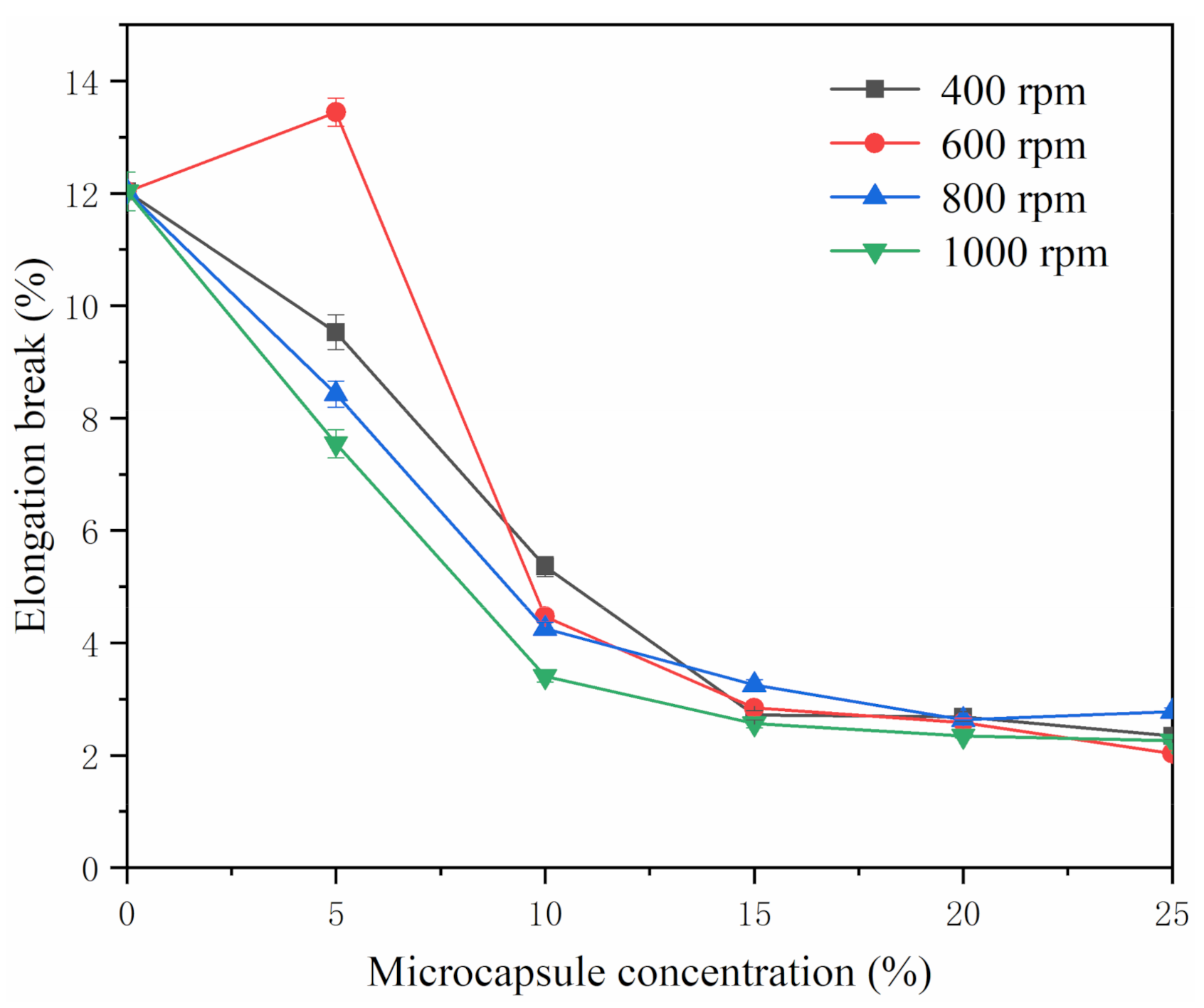
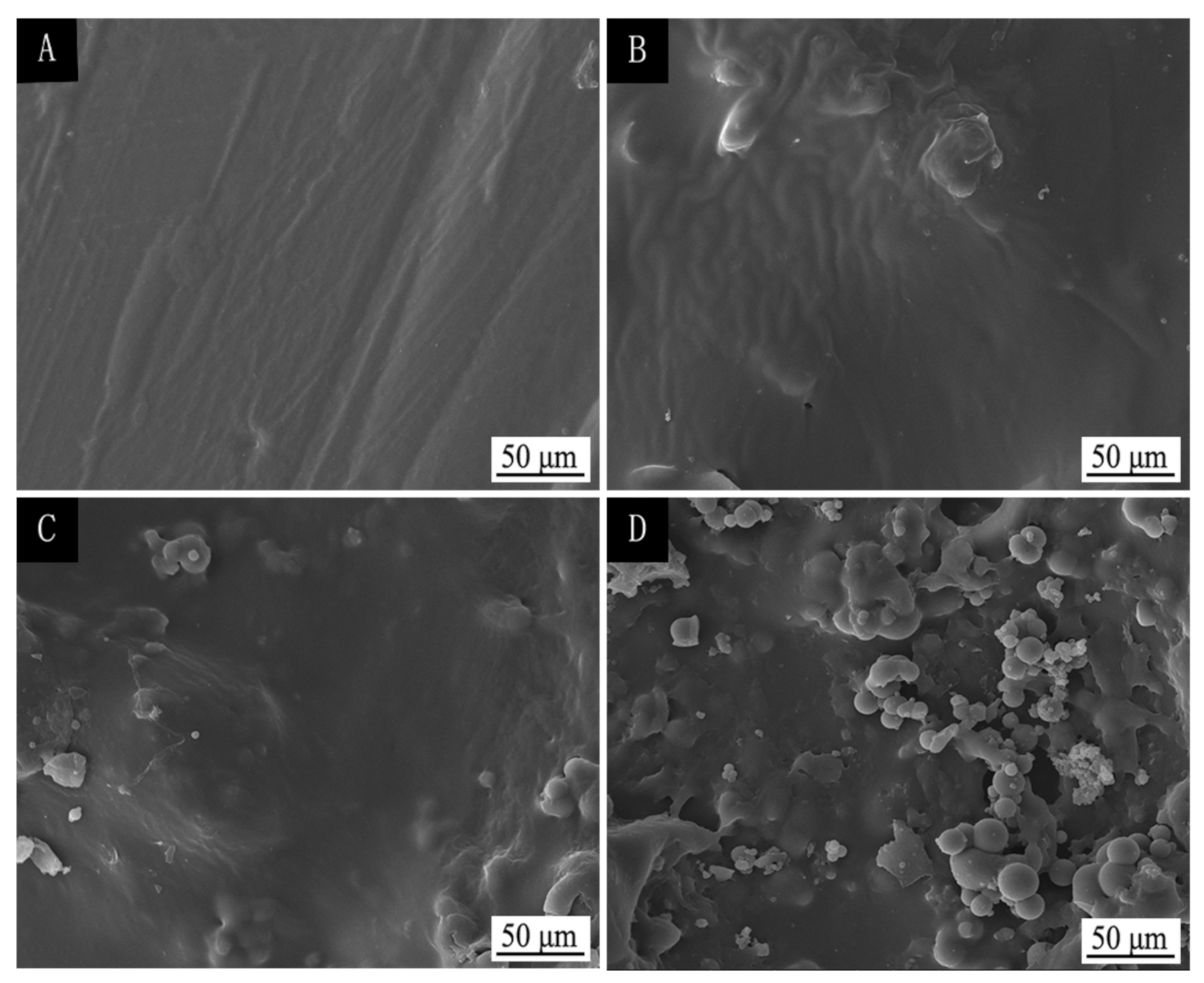

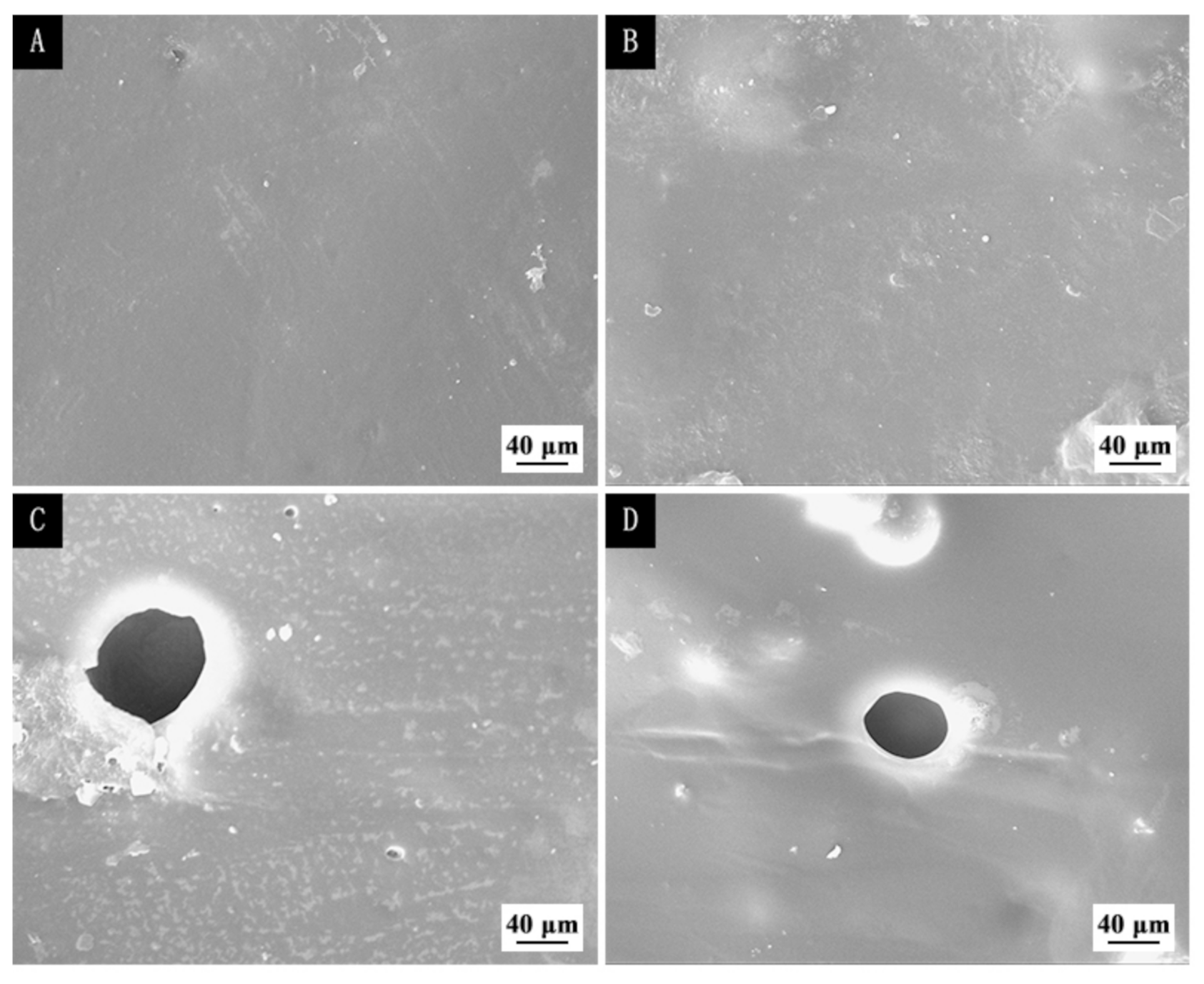
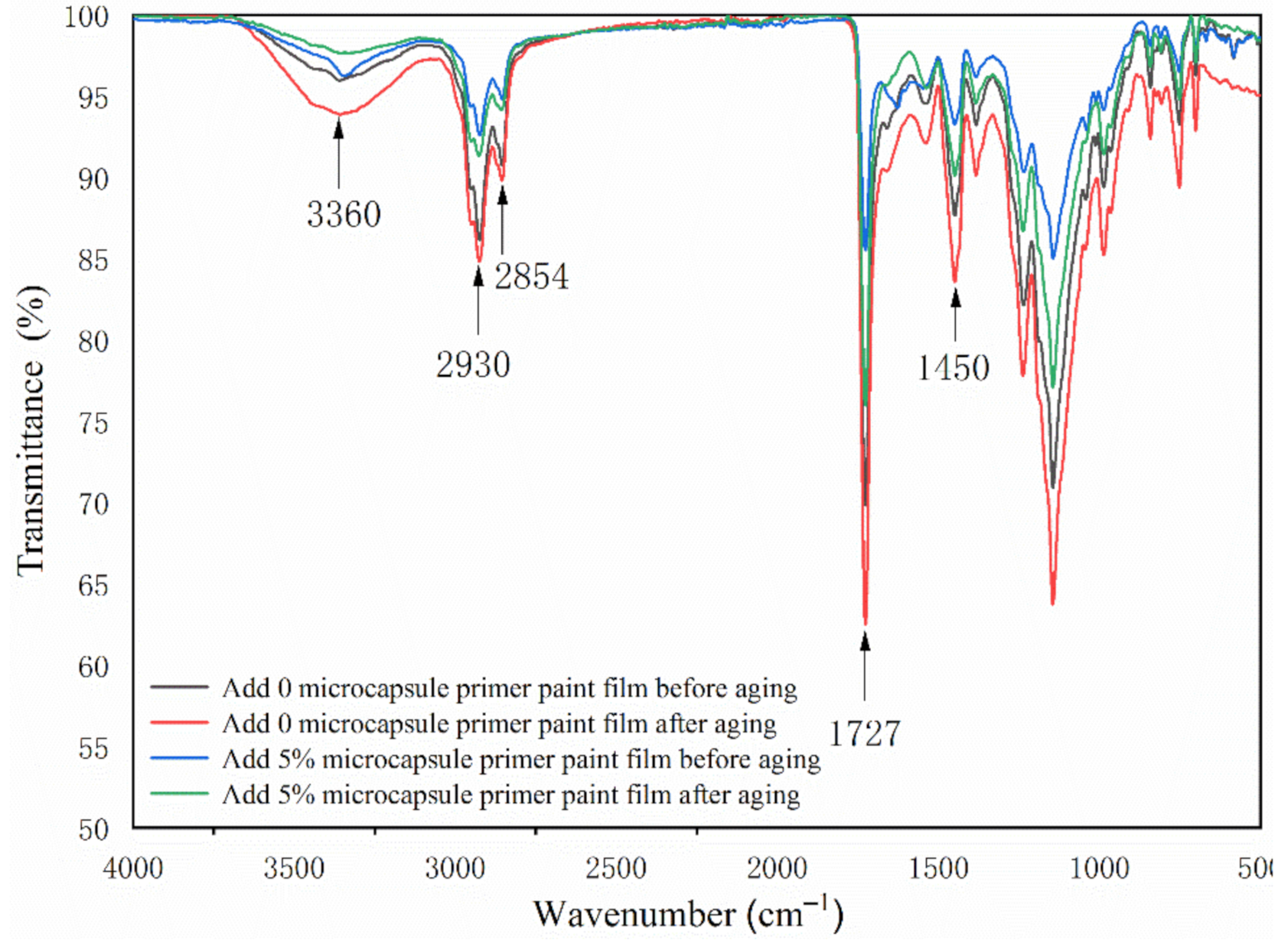

| Experimental Materials | Molecular Mass (g/mol) | CAS | Manufacturer |
|---|---|---|---|
| 37.0% Formaldehyde | 30.03 | 50-00-0 | Jining Hengtai Chemical Co., Ltd., Jining, China |
| Melamine | 126.15 | 108-78-1 | Henan Ningjie Chemical Products Co., Ltd., Zhengzhou, China |
| Triethanolamine | 149.19 | 102-71-6 | Henan Yuheng Chemical Co., Ltd., Zhengzhou, China |
| Sodium dodecyl benzene sulfonate (SDBS) | 348.48 | 25155-30-0 | Xi’an Tianmao Chemical Co., Ltd., Xi’an, China |
| Citric acid monohydrate | 210.14 | 5949-29-1 | Nanjing Chemical Reagent Co., Ltd., Nanjing, China |
| Anhydrous ethanol | 46.07 | 64-17-5 | Tianjin Fuyu Fine Chemical Co., Ltd., Tianjin, China |
| Tilia europaea L. (100 mm × 65 mm × 4 mm) | - | - | Guangdong Yihua Life Science and Technology Co., Ltd., Guangzhou, China |
| Waterborne primer | - | - | Dulux (Changzhou) Co., Ltd., Changzhou, China |
| Shellac | Jinan Dahui Chemical Technology Co., Ltd., Jinan, China | ||
| 15.0% NaCl solution | - | - | Self-made |
| 70% Medical ethanol | - | - | Qingdao Heinrich Innoway Disinfection Technology Co., Ltd., Qingdao, China |
| Detergent | - | - | Shanghai and Huangbai Cat Co., Ltd., Shanghai, China |
| Red ink | - | - | Shanghai Fine Cultural Products Co., Ltd., Shanghai, China |
| Stirring Rate (rpm) | Microcapsule Concentration (%) | 20° Gloss (%) | 60° Gloss (%) | 85° Gloss (%) |
|---|---|---|---|---|
| 400 | 0 | 4.9 ± 0.1 | 20.2 ± 0.5 | 19.6 ± 0.6 |
| 5.0 | 1.7 ± 0 | 9.1 ± 0.2 | 7.2 ± 0.2 | |
| 10.0 | 1.0 ± 0 | 2.2 ± 0 | 0.3 ± 0 | |
| 15.0 | 1.1 ± 0 | 1.6 ± 0 | 0.2 ± 0 | |
| 20.0 | 1.1 ± 0 | 1.3 ± 0 | 0.1 ± 0 | |
| 25.0 | 1.1 ± 0 | 1.4 ± 0 | 0.1 ± 0 | |
| 600 | 5.0 | 1.8 ± 0 | 8.4 ± 0 | 2.4 ± 0 |
| 10.0 | 1.1 ± 0 | 2.4 ± 0 | 0.3 ± 0 | |
| 15.0 | 1.1 ± 0 | 1.6 ± 0 | 0.2 ± 0 | |
| 20.0 | 1.0 ± 0 | 1.2 ± 0 | 0 ± 0 | |
| 25.0 | 1.2 ± 0 | 1.4 ± 0 | 0 ± 0 | |
| 800 | 5.0 | 1.2 ± 0 | 1.4 ± 0 | 0.2 ± 0 |
| 10.0 | 1.1 ± 0 | 1.4 ± 0 | 0.1 ± 0 | |
| 15.0 | 1.2 ± 0 | 1.3 ± 0 | 0.2 ± 0 | |
| 20.0 | 1.1 ± 0 | 1.4 ± 0 | 0 ± 0 | |
| 25.0 | 0.9 ± 0 | 1.2 ± 0 | 0 ± 0 | |
| 1000 | 5.0 | 1.3 ± 0 | 1.6 ± 0 | 0.1 ± 0 |
| 10.0 | 1.0 ± 0 | 1.5 ± 0 | 0.1 ± 0 | |
| 15.0 | 1.1 ± 0 | 1.4 ± 0 | 0 ± 0 | |
| 20.0 | 1.1 ± 0 | 1.2 ± 0 | 0.1 ± 0 | |
| 25.0 | 1.1 ± 0 | 1.2 ± 0 | 0 ± 0 |
| Microcapsule Concentration (%) | Adhesion (Grade) | |||
|---|---|---|---|---|
| Stirring Rate 400 rpm | Stirring Rate 600 rpm | Stirring Rate 800 rpm | Stirring Rate 1000 rpm | |
| 0 | 0 ± 0 | 0 ± 0 | 0 ± 0 | 0 ± 0 |
| 5.0 | 1 ± 0 | 0 ± 0 | 1 ± 0 | 1 ± 0 |
| 10.0 | 2 ± 0 | 1 ± 0 | 1 ± 0 | 1 ± 0 |
| 15.0 | 2 ± 0 | 1 ± 0 | 1 ± 0 | 1 ± 0 |
| 20.0 | 3 ± 0 | 2 ± 0 | 2 ± 0 | 2 ± 0 |
| 25.0 | 4 ± 0 | 2 ± 0 | 2 ± 0 | 2 ± 0 |
| Microcapsule Concentration (%) | Hardness | |||
|---|---|---|---|---|
| Stirring Rate 400 rpm | Stirring Rate 600 rpm | Stirring Rate 800 rpm | Stirring Rate 1000 rpm | |
| 0 | HB ± 0 | HB ± 0 | HB ± 0 | HB ± 0 |
| 5.0 | 4H ± 0 | 3H ± 0 | 4H ± 0 | 3H ± 0 |
| 10.0 | 5H ± 0 | 4H ± 0 | 3H ± 0 | 3H ± 0 |
| 15.0 | 3H ± 0 | 3H ± 0 | 3H ± 0 | 4H ± 0 |
| 20.0 | H ± 0 | 4H ± 0 | 4H ± 0 | 4H ± 0 |
| 25.0 | 5H ± 0 | 3H ± 0 | 5H ± 0 | 5H ± 0 |
| Microcapsule Concentration (%) | Impact Resistance (kg·cm) | |||
|---|---|---|---|---|
| Stirring Rate 400 rpm | Stirring Rate 600 rpm | Stirring Rate 800 rpm | Stirring Rate 1000 rpm | |
| 0 | 5.0 ± 0 | 5.0 ± 0 | 5.0 ± 0 | 5.0 ± 0 |
| 5.0 | 5.0 ± 0 | 12.0 ± 0 | 19.0 ± 0 | 7.0 ± 0 |
| 10.0 | 9.0 ± 0 | 14.0 ± 0 | 21.0 ± 0.8 | 25.0 ± 0.8 |
| 15.0 | 8.0 ± 0 | 12.0 ± 0 | 13.0 ± 0 | 20.0 ± 0.8 |
| 20.0 | 7.0 ± 0 | 11.0 ± 0 | 10.0 ± 0 | 15.0 ± 0 |
| 25.0 | 7.0 ± 0 | 10.0 ± 0 | 10.0 ± 0 | 12.0 ± 0 |
| Stirring Rate (rpm) | Microcapsule Concentration (%) | NaCl | Ethanol | Detergent | Red Ink |
|---|---|---|---|---|---|
| 400 | 0 | 50.2 ± 1.3 | 6.3 ± 0.2 | 12.0 ± 0.3 | 61.0 ± 1.5 |
| 5.0 | 4.9 ± 0 | 5.3 ± 0.1 | 3.3 ± 0 | 47.8 ± 1.6 | |
| 10.0 | 6.2 ± 0.2 | 2.7 ± 0 | 6.7 ± 0.2 | 23.4 ± 0.5 | |
| 15.0 | 4.1 ± 0.1 | 4.8 ± 0.1 | 8.2 ± 0.2 | 63.8 ± 1.4 | |
| 20.0 | 6.1 ± 0.1 | 7.6 ± 0.2 | 9.8 ± 0.2 | 67.0 ± 1.8 | |
| 25.0 | 3.2 ± 0 | 3.6 ± 0 | 11.2 ± 0.2 | 52.7 ± 1.8 | |
| 600 | 0 | 50.2 ± 1.4 | 6.3 ± 6.5 | 12.0 ± 0.3 | 61.0 ± 2.0 |
| 5.0 | 4.2 ± 0.1 | 3.9 ± 0 | 3.1 ± 0 | 40.6 ± 1.3 | |
| 10.0 | 1.8 ± 0 | 2.5 ± 0 | 1.3 ± 0 | 3.9 ± 0 | |
| 15.0 | 1.7 ± 0 | 3.3 ± 0 | 2.1 ± 0 | 39.2 ± 1.5 | |
| 20.0 | 3.9 ± 0 | 4.1 ± 0.1 | 8.9 ± 0.2 | 29.9 ± 0.9 | |
| 25.0 | 12.9 ± 0.3 | 18.6 ± 0.5 | 18.8 ± 0.6 | 28.6 ± 1.3 | |
| 800 | 0 | 50.2 ± 1.4 | 6.3 ± 0.2 | 12.0 ± 0.3 | 61.0 ± 1.3 |
| 5.0 | 12.3 ± 0.3 | 14.7 ± 0.3 | 14.9 ± 0.4 | 14.4 ± 0.4 | |
| 10.0 | 2.8 ± 0 | 3.3 ± 0 | 10.1 ± 0.2 | 46.4 ± 1.0 | |
| 15.0 | 2.1 ± 0 | 7.3 ± 0.2 | 7.6 ± 0.1 | 52.4 ± 1.0 | |
| 20.0 | 7.0 ± 0 | 12.7 ± 0.5 | 7.2 ± 0.2 | 49.1 ± 1.5 | |
| 25.0 | 13.2 ± 0.2 | 10.6 ± 0.3 | 9.0 ± 0.1 | 32.8 ± 0.6 | |
| 1000 | 0 | 50.2 ± 1.7 | 6.3 ± 0.2 | 12.0 ± 0.3 | 61.0 ± 2 |
| 5.0 | 5.6 ± 0.1 | 7.9 ± 0.1 | 5.3 ± 0 | 7.2 ± 0.1 | |
| 10.0 | 6.3 ± 0.2 | 8.9 ± 0.2 | 4.6 ± 0.1 | 5.7 ± 0.1 | |
| 15.0 | 5.4 ± 0.1 | 26.0 ± 0.8 | 7.0 ± 0.1 | 51.4 ± 1.5 | |
| 20.0 | 10.7 ± 0.2 | 5.8 ± 0.1 | 13.1 ± 0.3 | 32.3 ± 0.6 | |
| 25.0 | 6.9 ± 0.1 | 16.9 ± 0.5 | 28.5 ± 0.8 | 20.9 ± 0.4 |
| Stirring Rate (rpm) | Microcapsule Concentration (%) | NaCl | Ethanol | Detergent | Red Ink |
|---|---|---|---|---|---|
| 400 | 0 | 9.8 ± 0.2 | 9.6 ± 0.2 | 10.0 ± 0.2 | 11.7 ± 0.4 |
| 5.0 | 6.4 ± 0.2 | 6.1 ± 0.1 | 7.6 ± 0.1 | 7.1 ± 0.2 | |
| 10.0 | 2.7 ± 0 | 2.6 ± 0 | 2.3 ± 0 | 2.1 ± 0 | |
| 15.0 | 1.5 ± 0 | 1.5 ± 0 | 1.5 ± 0 | 0.7 ± 0 | |
| 20.0 | 1.5 ± 0 | 1.5 ± 0 | 2.0 ± 0 | 0.6 ± 0 | |
| 25.0 | 1.4 ± 0 | 1.4 ± 0 | 1.6 ± 0 | 0.8 ± 0 | |
| 600 | 0 | 9.8 ± 0.2 | 9.6 ± 0.1 | 10.0 ± 0.2 | 11.7 ± 0.4 |
| 5.0 | 6.4 ± 0.1 | 5.2 ± 0.1 | 6.0 ± 0.1 | 5.3 ± 0.1 | |
| 10.0 | 2.0 ± 0 | 1.0 ± 0 | 2.6 ± 0 | 0.9 ± 0 | |
| 15.0 | 1.3 ± 0 | 1.0 ± 0 | 1.3 ± 0 | 1.4 ± 0 | |
| 20.0 | 1.5 ± 0 | 1.6 ± 0 | 1.5 ± 0 | 1.1 ± 0 | |
| 25.0 | 1.4 ± 0 | 1.4 ± 0 | 1.6 ± 0 | 1.7 ± 0 | |
| 800 | 0 | 1.4 ± 0 | 1.4 ± 0 | 1.2 ± 0 | 0.9 ± 0 |
| 5.0 | 1.4 ± 0 | 1.4 ± 0 | 1.5 ± 0 | 1.4 ± 0 | |
| 10.0 | 1.4 ± 0 | 1.4 ± 0 | 1.2 ± 0 | 0.9 ± 0 | |
| 15.0 | 1.6 ± 0 | 1.5 ± 0 | 1.8 ± 0 | 0.8 ± 0 | |
| 20.0 | 1.7 ± 0 | 1.6 ± 0 | 1.8 ± 0 | 0.8 ± 0 | |
| 25.0 | 1.7 ± 0 | 1.6 ± 0 | 1.8 ± 0 | 1.0 ± 0 | |
| 1000 | 0 | 9.8 ± 0.2 | 9.6 ± 0.2 | 10.0 ± 0.2 | 11.7 ± 0.9 |
| 5.0 | 1.6 ± 0 | 1.2 ± 0 | 1.7 ± 0 | 1.7 ± 0 | |
| 10.0 | 1.5 ± 0 | 1.6 ± 0 | 1.5 ± 0 | 1.4 ± 0 | |
| 15.0 | 1.7 ± 0 | 1.5 ± 0 | 1.7 ± 0 | 1.4 ± 0 | |
| 20.0 | 1.6 ± 0 | 1.5 ± 0 | 1.6 ± 0 | 1.0 ± 0 | |
| 25.0 | 1.5 ± 0 | 1.6 ± 0 | 1.5 ± 0 | 0.9 ± 0 |
| Peak Value | Functional Group | Substance |
|---|---|---|
| 1447 cm−1/2930 cm−1/2865 cm−1 | C–H | - |
| 2930 cm−1/2854 cm−1/1450 cm−1 | –CH2 | - |
| 1600 cm−1 | C=N | MF resin |
| 1542 cm−1/3500–3300 cm−1 | N–H | |
| 1726 cm−1 | C=O | waterborne acrylic resin |
| 1750 cm−1 | –COOH | shellac |
| Aging Environment | Microcapsule Concentration (%) | Aging Time (h) | L* | a* | b* | c* | H* | ΔE* |
|---|---|---|---|---|---|---|---|---|
| UV | 0 | 0 | 63.0 ± 2.4 | 17.1 ± 0.2 | 29.1 ± 0.7 | 34.1 ± 0.5 | 58.6 ± 1.3 | - |
| 24 | 54.2 ± 1.6 | 15.1 ± 0.3 | 22.2 ± 1.1 | 26.9 ± 0.5 | 55.7 ± 1.7 | 11.3 ± 0.2 | ||
| 5.0 | 0 | 70.7 ± 2.1 | 13.3 ± 0.3 | 20.7 ± 0.6 | 24.6 ± 0.9 | 57.3 ± 1.5 | - | |
| 24 | 64.0 ± 1.9 | 13.1 ± 0.4 | 17.2 ± 0.4 | 21.6 ± 0.4 | 52.6 ± 1.8 | 7.5 ± 0.2 |
| Microcapsule Concentration (%) | Aging Time (h) | 20° | 60° | 80° |
|---|---|---|---|---|
| 0 | 0 | 2.0 ± 0.1 | 5.1 ± 0.1 | 3.1 ± 0 |
| 24 | 1.9 ± 0 | 4.9 ± 0.1 | 2.1 ± 0 | |
| 5.0 | 0 | 1.8 ± 0 | 4.7 ± 0.2 | 3.0 ± 0 |
| 24 | 1.3 ± 0 | 3.1 ± 0 | 1.5 ± 0 |
Publisher’s Note: MDPI stays neutral with regard to jurisdictional claims in published maps and institutional affiliations. |
© 2021 by the authors. Licensee MDPI, Basel, Switzerland. This article is an open access article distributed under the terms and conditions of the Creative Commons Attribution (CC BY) license (https://creativecommons.org/licenses/by/4.0/).
Share and Cite
Yan, X.; Tao, Y.; Chang, Y. Effect of Shellac Waterborne Coating Microcapsules on the Optical, Mechanical and Self-Healing Properties of Waterborne Primer on Tilia europaea L. Wood. Coatings 2021, 11, 785. https://doi.org/10.3390/coatings11070785
Yan X, Tao Y, Chang Y. Effect of Shellac Waterborne Coating Microcapsules on the Optical, Mechanical and Self-Healing Properties of Waterborne Primer on Tilia europaea L. Wood. Coatings. 2021; 11(7):785. https://doi.org/10.3390/coatings11070785
Chicago/Turabian StyleYan, Xiaoxing, Yu Tao, and Yijuan Chang. 2021. "Effect of Shellac Waterborne Coating Microcapsules on the Optical, Mechanical and Self-Healing Properties of Waterborne Primer on Tilia europaea L. Wood" Coatings 11, no. 7: 785. https://doi.org/10.3390/coatings11070785
APA StyleYan, X., Tao, Y., & Chang, Y. (2021). Effect of Shellac Waterborne Coating Microcapsules on the Optical, Mechanical and Self-Healing Properties of Waterborne Primer on Tilia europaea L. Wood. Coatings, 11(7), 785. https://doi.org/10.3390/coatings11070785





